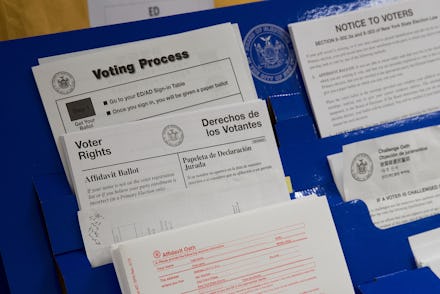Voting Day 2016: Everything you need to know ahead of Nov. 8

Election Day is almost upon us, and U.S. voters are about to seal the fate of the country for the next four years. Before you head to the polls, here's what to look out for on Election Day 2016 — from the dos and don'ts of your local polling place to the swing states to watch as results come in.
1. Ohio and Florida
There's a reason these two states get so much attention during presidential elections — they both have, historically, been extremely important in predicting who will win the presidency. In fact, Ohio's outcome has predicted every presidential election since 1964. And Florida's diversity and population size make it an important predictor of the election — but they also mean that Florida is often a close contest.
In the 2012 presidential election, Florida was the only state where the vote was decided by a margin that less than 1% — Barack Obama narrowly beat out Republican rival Mitt Romney, 50% to 49.1%. But in this unusual election, it may be possible for Clinton to win despite current predictions indicating Trump will take Ohio — and there is even a possibility of a Clinton win without either state.
2. Voter suppression
A week out from Election Day there had already been numerous attempts at misleading and dissuading voters. Earlier in November, fake ads that had been designed to look like Clinton campaign materials began circulating on Twitter, urging voters to "vote from home" by texting — which is, by the way, completely impossible.
And, by the end of October, the Democratic Party had already filed lawsuits in four states — Pennsylvania, Nevada, Arizona and Ohio — that allege the Trump campaign is violating the laws that exist to protect voters with its planned volunteer "election observer" program.
Trump's plan to post his supports at the polls to monitor for voter fraud is not only unnecessary — voter fraud is basically nonexistent in the U.S. — many fear that Trump's calls to monitor polling places in specific areas is a coded call to intimidate voters based on race or ethnicity. The American Civil Liberties Union has created a "know your rights" resource for voters that outlines what to do when faced with voter intimidation.
3. Polling place rules
There are some crucial things to know about what not to do at the polls — so you don't wind up like Justin Timberlake, who was caught taking an illegal voting selfie when he voted in his hometown of Memphis, Tennessee, in October. Tennessee is one of the 15 states in which taking a photograph in the voting booth is illegal, and some states have stricter rules than others regarding pics at the polls. So check your local rules before snapping that selfie.
There are also rules about what you can and can't wear to the polling place — in October, a man in Texas was arrested for refusing to turn his "basket of deplorables" T-shirt inside-out when he went to cast his vote. That's because many polling places ban campaign materials in or around polling areas — and that often includes hats, shirts and buttons that support specific candidates.
4. When will the election be called?
When can we expect Election Day to officially end? The times at which polls open and close vary state-by-state — you can look yours up here, but the election isn't over right when the polls close. Historically, the election results haven't always been clear by the end of Election Day. According to the Charlotte Observer, the last two elections were called for Obama before midnight on the East Coast, but things weren't as clear in pervious years.
In 2004, the race wasn't called for George W. Bush until Ohio's votes were counted the next day, and in 2000, the election wasn't called for Bush until Dec. 13. And, with Trump's refusal to promise that he will accept the results of the election and repeated claims that the election will be rigged — despite a complete lack of evidence — it's definitely possible that the election won't be decided by the end of Election Day.
5. Voter turnout: what to expect
According to a Pew Research Center report from August, voter turnout in the United States is low compared to other developed countries. In 2012, just 129.1 million people voted, out of about 241 million people of voting age. That's a turnout of 53.6%, far lower than the turnout in Belgium, which had the highest voter turnout in a recent national election at 87.2%.
But Belgium has something the U.S. doesn't — compulsory voting. And, even when not strictly enforced, compulsory voting can have a "dramatic" effect on the percentage of eligible people who cast a vote, according to the Pew report. In the U.S., where people voluntarily register to vote, only 65% of people of voting age are even registered.
But will this year be different? On Oct. 31, the New York Times reported that 22 million early or absentee votes had already been cast, and, according to the Times, "in many states, the number of early voters is higher than at the same point in the 2012 cycle." But, while early voting was up among certain populations, like Hispanic voters, it fell among voters between the ages of 18 and 29. We'll just have to wait for Nov. 8 to see if those trends continue on Election Day.